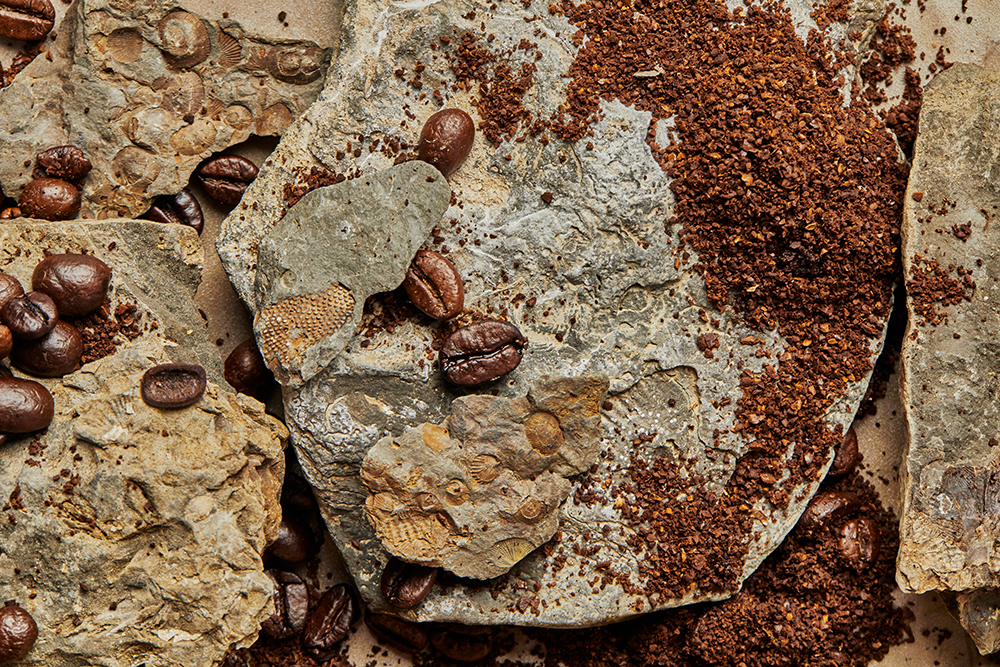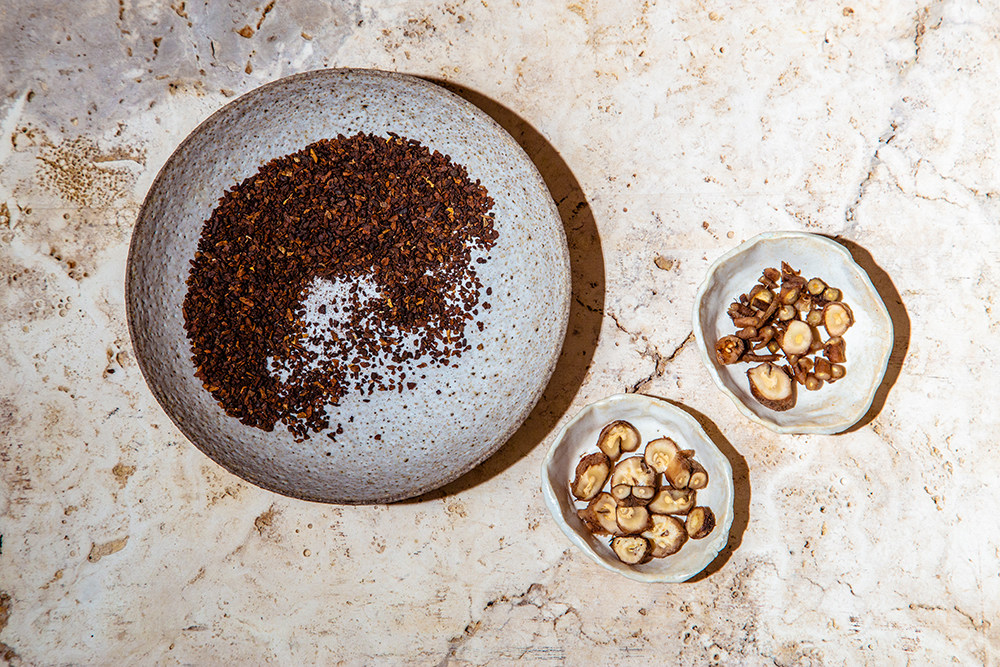 Fossils and coffee beans; Photo by Laura Murray
Fossils and coffee beans; Photo by Laura MurrayMy contacts crease with late afternoon fatigue. Rephrased: My eyes tell me to step outside, where the air sighs into the low seventies, and the sun sends its last sheets of yellow light over dry grass. The weather has finally bequeathed us an evening cool enough to have a late coffee on the porch. I still call it “coffee” out of habit. 30 years and I forget it’s not quite coffee; it's something uncannily similar. A gesture at coffee, with a difference both earthy and sweet.
My partner and I are planning a coffee cupping tomorrow, for a real cup of Arabica coffee (albeit, a new hybrid) from an experimental harvest in South Carolina. A new coffee cupping bar opened up in our town where you can still get fresh-ground, real cup of coffee for about $25. My favorite barista there cherishes an old coffee grinder most of us pitched years ago—a creaky burr grinder with 30 coarseness settings. She is young enough to love coffee purely as a quaint luxury, perhaps akin to how I came of age viewing grass-fed beef and hand-made cheese as an expensive whim for culinary enthusiasts. It's just that, unlike expensive steak and fine cheese, coffee isn’t simply expensive; it’s essentially extinct in the form it once was.
It is October 12, 2061 and the world is too hot and too dry for coffee production in most of the world’s traditional coffee farming regions, including Central Africa and large swaths of Central America. Unfortunately, without a democratic majority in congress, more aggressive climate policies were not enacted until the mid 2020’s. Not soon enough to make up for lost time from roll-backs in climate policies laid out in the Paris Climate accord in the late 2010’s and early 2020’s.


Most folks don’t remember the slow decrease in availability of Arabica coffee, but they likely remember the coffee crash of 2032. Temperatures that year in Brazil sustained all-time highs, impacting even the most remote mountain sides pocketed with coffee plantations. A bacteria that attacks the plant's roots, typically kept under control by night-time frosts, which prevented the bacteria from reproducing, roared into life in a summer of relentless heat. The bug wiped out nearly every coffee plantation in the country and quickly impacted nearby coffee regions, jumping to West Africa and effectively destroying almost the entire strain of Arabica plants. Over the next few years, the entire coffee belt collapsed, in various degrees of severity, under ceaseless droughts and disease.
A slow recovery led by Western biotech firms with coffee varietals engineered to withstand higher temperatures and the heat-loving bacteria have been distributed throughout Central America. But only farmers who can pay for the rights to the patented seeds are getting a chance to salvage their farms, and many have been left out permanently. (Costa Rica subsidized the distribution, and remains the only socially sustainable coffee producing country in Central America.) Engineered coffee seeds are so expensive that farmers growing them can no longer afford to roast and drink coffee themselves—not even the cheaper stuff. They’ve mostly switched to black tea. A trend that has been growing for decades has been sharply exacerbated: Coffee has shifted to appease Western palettes—there is a rumor one particular variety was engineered specifically to mix well with oat milk, popularized by coffee connoisseurs in the United States and Scandinavia in the early 2020s.
That’s when the alternative coffees arrived, the ones my partner and I brew each morning. Alternative “analog” coffees come in two forms: some made from toasted sorghum that has been sweetened with chicory, and others made from a blend of carob and ashwagandha. Seen as environmentally responsible and local alternatives to a fraught coffee industry, these blends are served in new artisanal cafés which sprouted up in cities to redefine coffee-drinking culture. Most coffee shops these days offer both some kind of real coffee (an expensive hybrid still surviving in places like Costa Rica) and koffee, the catch-all name for the alternative artisanal coffee beverages.
While my parents stay desperately committed to the expensive GMO coffees, I have chosen the latter. I use my old porcelain pour over to brew a brand of carob ashwagandha koffee most mornings, and have grown accustomed to its particular woodsy ping. It's the most popular type of koffee you can buy these days, with added lipids and caffeine, and we find it has just enough acidity and a touch of sweetness. It’s not often we bother to try new brands, since many grocery stores are formatted like warehouses now, with big drop drones that come to your door. (Implemented largely to reduce food waste and to make the food supply more robust to coronavirus outbreaks). Admittedly, it is easier to simply reorder our previous week’s drop and so, our koffee habit is decidedly a bit monotonous.
That is why we go to the cuppings, which are a way to try endangered and heirloom types of coffees at our local roastery. They have live jazz and European-style cheeses and a Q Grader (a sort of coffee sommelier) who comes to talk you through each cup. On our last visit, we ordered a flight of coffees from the Blue Ridge Mountains in Georgia, where a family farm has employed the expertise of Brazilian immigrants, all former coffee farmers, to re-establish a Arabica farm in the states. Most of the beans on their menu are beans grown at similar experimental farms in the United States, the Caribbean, and even Russia, where temperatures are now quite similar to the old world coffee regions. Every once in a while, they include a hybrid variety from old coffee regions, perhaps for nostalgia’s sake.
Of course, large corporate coffee chains had to pivot, too, but with cost in mind to retain their customers. Lab-grown coffee companies became the primary supplier for Keurig, Dunkin Donuts and Starbucks, which marketed the new drink heavily as a way to combat deforestation, playing the role of hero to distance themselves from the crumbling coffee supply chain. (They never managed to answer the question of what millions of displaced coffee farmers might do, even with all those protected forests.) Importantly, they touted it as an identical analog to the stuff from beans. No one really believed it, but after enough time, caffeine was caffeine, and so long as it wafted with the same familiar smell, most people acquiesced.
And in fact, we’ve acquiesced to much on our tables, despite menus using familiar words for novel foods. Milk slowly became oat milk and almond milk; coffee slowly became koffee; burgers and seafood at all but a few chain restaurants became lab-grown alternatives; fishermen are more often folks who work in “finless” fish labs than out on the ocean. The lab-grown meat battle played out in the courts—a majority-Democratic Senate finally ruled that alternative meats could use the word “meat,” and were entitled to significant carbon tax breaks, creating a boom in the industry. Restaurant chains sought to save money on the huge cost-savings alternative meats now provided. It took years for independently-owned restaurants to come back after the 2020-2022 Pandemic, and some of those do, of course, still source from sustainable meat sources. But for most of us, lab-grown meat is the expected fare at bars and cafeterias, at baseball stadiums and fast food joints.
We’ve gained new foods, too—cactus farms have sprouted in the New Brush, supported heavily by government subsidies enforced by treaties drafted by global Dry Area Resiliency organizations. A popular American adaptation of the green bean casserole now uses sliced cactus paddles in place of the namesake ingredient. We have millet flatbreads and breadfruit ice cream and pomegranate wine, all made from plants that can withstand high temperatures and sparse rain. In fact, I am quite endeared to koffee as well. It’s not simply a coffee replacement, but a new drink—one that gives us a chance to support something more local and, perhaps, something more likely to survive.